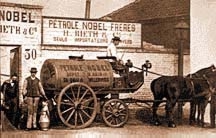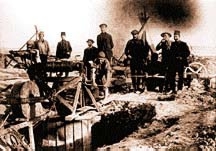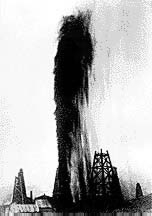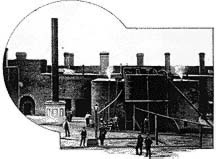|
in Azerbaijan by Dr. Khoshbakht Yusifzade
Since ancient times, Azerbaijan
has been one of those regions of the world where there is a long
history of involvement with oil. A chronology follows of some
of the major developments as they occurred in Azerbaijan. 1806 Records indicate that there were 50 oil wells on the Absheron Peninsula. 1821 By this time, approximately 120 oil wells had been dug on Absheron. 1820-1830 Industrial refining of oil started. A distillation machine for obtaining kerosene was invented in Baku. 1840-1850 Sea communication was established for the transport of kerosene between Baku and Astrakhan (city at delta of Caspian Sea, north of Azerbaijan). 1844 The first oil well ever to be
drilled (not dug by hand) took place in Bibi Heybat. This happened
for the first time in the entire world for the oil industry.
Hand dug wells continued to be used for the production of oil
on Absheron until 1872. Ten years later, Americans started drilling
wells in Pennsylvania.
1859Kokarev and Kurbanin built the first factory for acquiring paraffin and kerosene near Surakhani (near the Ancient Fire Worshipper's Temple). 1860-1870
There were 218 wells on Absheron. Construction was like a stepped, inverted pyramid. 1863The first oil distillation machine was constructed by Javad Malikov followed by Mirzoyev, Taghiyev and other entrepreneurs. By 1873, about 50 oil distillation installations were functioning in Baku. 1870-1890Oil gushers were quite common. In 1873, one of the most prolific wells in Bibi Heyat spewed out 90 million poods of oil within three months. In 1875, a second more powerful well in Balakhanli dug to a depth of 95.85 meters produced 240-330 tons of oil every day for a month. 1871One of the oils that had been drilled produced 70 barrels of oil per day. 1872Foreign owners began purchasing oil fields on the Absheron Peninsula. The Nobels and Rothchilds started getting involved buying and operating some wells. 1873Exploration and development began in some of the largest fields known to exist in the world at that time on Absheron near the villages of Balakhanli, Sabunchi, Ramana and Bibi Heybat. Total recoverable reserves was more than 500 million tons. 1874"The Nobel Brothers Association" was established. The association began constructing oil pipelines to connect the oil fields with distillation factories in Baku. 1875Lubricating oil was produced in Azerbaijan for the first time in the world. Three years later it was already in great demand on the world market. 1877The world's first steel tanker was ordered to be made by Ludwig Nobel. It was put into operation for transporting kerosene. Construction of pipelines between Sabunchi fields and factories of the "Black City" section of Baku was completed. 1878Opening of exhibits at international shows in Paris for oil products produced in Baku factories. These exhibits were highly evaluated by experts. Exhibitions followed in Brussels (1880) and London (1881). 1879Construction of the Sabunchi-"Black City" Railway was completed and the first electrical station was built in Balakhanli. 1882Uninterrupted oil distillation began at factories owned by the Nobel Brothers. 1883Construction of the Transcaucasian Railway between Baku and Batumi (Georgia) was completed and transportation of oil by rail tank cars was begun. 1884The Rothchilds established the "Caspian-Black Sea Oil Industrial and Commercial Association." 1885Baku kerosene squeezed American kerosene out of all markets. The export of American oil was reduced to 29.5 tons; two years before, America had exported 100.9 tons. 1887Construction of the Baku-Batumi pipeline began. 1890-1900Construction was completed for 26 oil pipelines which extended 277 kilometers in the Baku region connecting Balakhanli industrial region with the oil-refineries of Baku. Pipeline used to transport oil from fields to factories and open pit storage areas. 1896Another well produced close to 12 million poods and engineers could not get it under control for 15 days. Most of the oil flowed into the Caspian because there were no adequate means to contain it. 1899-1901Azerbaijan placed first in the world in the amount of oil extracted-11.5 million tons per year, a worldwide record at the time. In the U.S. only one million tons were being produced during this period. 1901Establishment of the Nobel Prizes from Alfred Nobel's will after his death (1833-1896) by consolidating the wealth from sales of explosives and from shares in the oil fields in Baku. Alfred was the largest single stock holder (12%) in the Nobel Brothers' Oil-Producing Company in Baku. The Nobel Family's decision to allow the withdrawal of Alfred's money was the decisive factor that enabled the Nobel Prizes to be established. (Prizes are awarded in Physics, Physiology, Chemistry, Literature and Peace. The Economics award was created in 1968). 1905Compressor exploitation was first applied in Balakhani wells. 1909Bibi-Heybat Bay landfill was
begun (in order to drill for oil below the water). The project
was completed in 1932. By 1925 the Bay was already supplying
10% of all the oil produced in Baku. 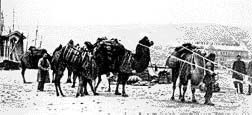 Oil being transported in caravans. 1911Rotary drilling was first applied in Surakhani. 1915Deep-sea pumps were used in a well in Ramana near Baku; 15 years later, the process would be employed in the U.S. In 1916 a gaslift was tested. 1918Oil production declined in Azerbaijan due to World War I, political revolutions in the region and frequent changes in the government. Many of the owners of oil fields were forced to leave the country when Soviets took over in 1920. 1920The Azerbaijan Polytechnical
Institute was founded. It was the first educational center in
all of Europe and Asia to train oil engineers.
1921Oil extraction fell to 2.46 million tons, reverting to a level produced in Azerbaijan in 1872. Publication of "Azerbaijan Oil Economy" began in Baku. 1923Thermal processing of drilling chisels was introduced. 1924First offshore oil ever to be extracted in the world (Bibi Heybat Bay). 1925About 10 percent of all the oil produced in Baku fields was being produced in Bibi-Heybat Bay. 1925-26Volume of drilling increased 70 times-from 3,400 meters in 1920-21 up to 203,000 meters. Oil extraction increased from 5.5 to 6.8 million tons. The technical re-equipping of oil-fields began. Rotary drilling was being used everywhere. Electrical engines began to replace steam engines. Products made by Baku machine-building factories almost completely met the needs of production in drilling and the oil-fields. Rocking mounts and bar pumps were manufactured. Wells that had been neglected during the war and during political upheavals were re-established. Geological and exploitation documents for all existing wells were organized by geologists. New fields were discovered in Absheron and Siyazan. 1927Electrical units regulating the quantity of circulation began to be widely used. 1934The Institute for Offshore Geological Research and Ship Drilling was established and metallic base platforms were constructed for off-shore drilling. 1940For the first time in the history of the oil industry, electrical drilling of wells were introduced (Kala oilfield). The first directional turbine drilling was used in Bail (2,000 meters depth). 1941Drilling of the deepest oil well (3,200-3,400 meters) in USSR began in Housani region. Azerbaijan achieved its highest level of oil extraction in its history-23.5 million tons. Azerbaijan's high production accounted for 71.4 percent of the entire oil extraction in the Soviet Union that year, much of which was used in the war effort. 1941-1945Azerbaijan's production falls to 11.1 million tons or 63.2 percent of all oil produced in the USSR, Drilling was interrupted because of the war as manpower was concentrated on producing arms and weapons. 1942(September 25) Date that Hitler designated for his attack on Baku as he wanted Germany to gain access to Baku's oil supply. So determined was Hitler to seize Baku that he is quoted as having said, "Unless we get Baku's oil, the war is lost." After capturing Baku, Hitler planned to move on to Iran, Iraq and India. However, Stalingrad became Germany's first major defeat in Europe; Baku, which was next on Hitler's agenda, was never captured. 1943Kishlinskii Machine Factory, the largest machine building factory in the Republic, was established. Drilling and rehabilitation of fields was re-established. Material and technical supply was improved, technical and technological innovations were introduced. 1947Neft Dashlari Field (Oil Rocks)
was discovered which stimulated the development of offshore oil
extraction. For the first time in the world, a unique offshore
industry was built on metallic trestles (piles). Special cranes
for the installation of piers were constructed. Ships equipped
with cranes for lifting heavy loads were constructed; special
platforms for erecting individual foundation blocks were built;
companies were formed for manufacturing metal structures and
protecting them with anti-corrosion paints, and a specialized
transport and oilfield fleet was created. The development of
this gigantic offshore field played a decisive role in the increase
of offshore oil extraction. Piles were established at depths
up to 25 meters.
1949The Azmorneft Association was
founded in Baku in December which was committed to undertaking
exploration of offshore oilfield installations. Gipromorneftegaz
Scientific Research and Design Institute was founded to solve
major scientific and technological problems related to the offshore
oil industry. 1963Approximately 800 self-contained bases were built in the Caspian Sea. To date around 1300 fixed platforms and more than 450 kilometers of piers have been constructed. 1964-1968Level of production rapidly increased with around 21 million tons of oil being produced each year. 1968A self-lifting drilling installation was used for the first time. 1971Cumulative oil production in Azerbaijan reached one billion tons. 1977A deep-water offshore stationary platform was installed for the first time (84 meters). 1979 onwardsFour new multi-stratum fields, Gunashli (1979), Chirag (1985), Azeri (1988), Kapaz (1989) with combined resources of 700 million tons of oil and 200 billion cubic meters of gas were discovered at a depth of 200 meters. In addition, Azerbaijan today has considerable potential of perspective deposits of oil and gas-more than 220 undeveloped onshore and offshore structures. 1980 onwardsNon-explosive sources of stimulation (excitation) were applied in the sea during seismic searches. Geological and technical research stations were established and computer processing of industrial and geophysical data were introduced. 1981The ability to drill from a half-immersed drilling installation at a depth of 200 meters was created. 1994"Contract of the Century" signed for the joint development of the three major fields-Azeri, Chirag and Gunashli was originally signed with well-known foreign oil companies of the USA (Amoco, Unocal and Pennzoil); United Kingdom (British Petroleum and Ramco); Norway (Statoil); Russia (LUKoil), Turkey (Turkish Petroleum-TPAO) and Saudi Arabia (Delta Nimir). Since then Exxon (USA) and Itochu (Japan) have joined the consortium lead by AIOC (Azerbaijan International Operating Company). The $7.4 billion investment contract provides for oil extraction, transportation, construction of pipelines, and development of other crucial aspects of the infrastructure. 1994BMB (USA-Turkey) company began developing Karadagh and Umbaki Fields. The Azer Petoil got involved in Kalamaddin and Mishovdagh Fields. Anshad Petrol began developing Neftchala Field. All projects are joint ventures with SOCAR. 1995The Contract for the Karabakh structure was signed with the Pennzoil (US), Agip (Italy), LUKoil (Russia) and a joint venture LUKAgip. 1996The Contract for the Shah Deniz
structure is being finalized. Intensive talks are being carried
out with the British Petroleum (UK), Statoil (Norway), and TPAO
(Turkey), Elf Aquitaine (France) and LUKoil (Russia). Iran has
been invited to join the project. Back to Index
AI 4.2 (Summer 1996) |


